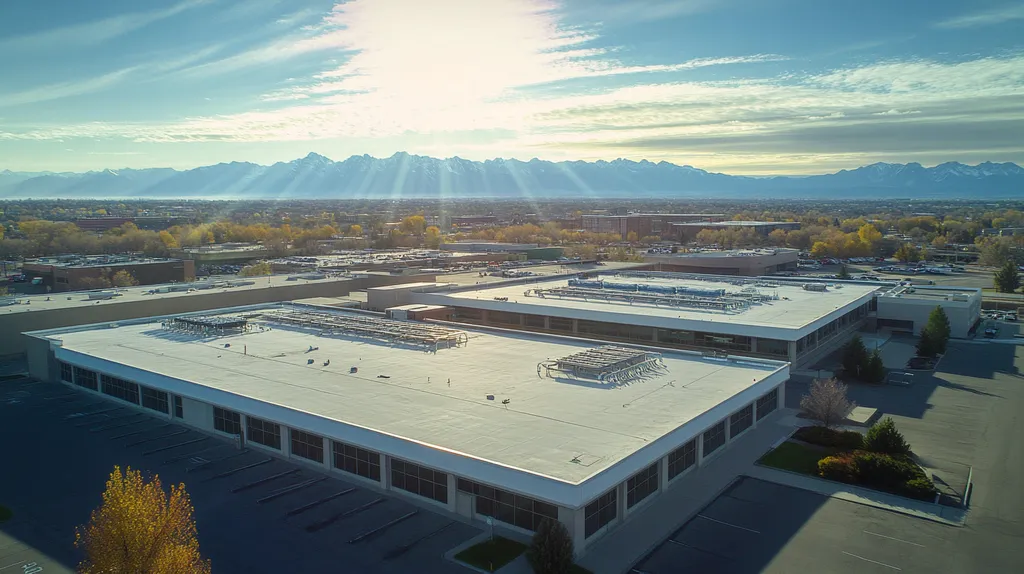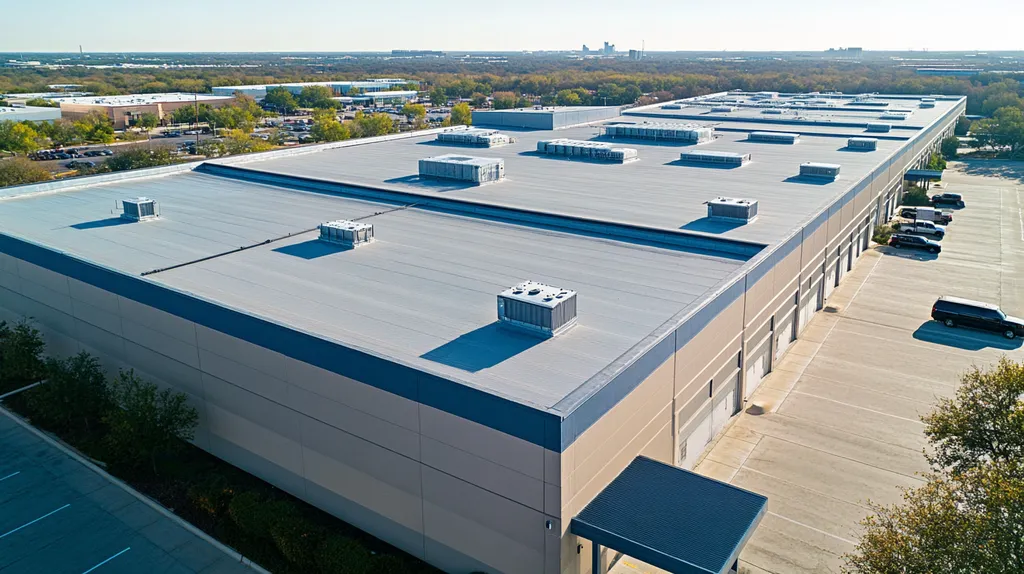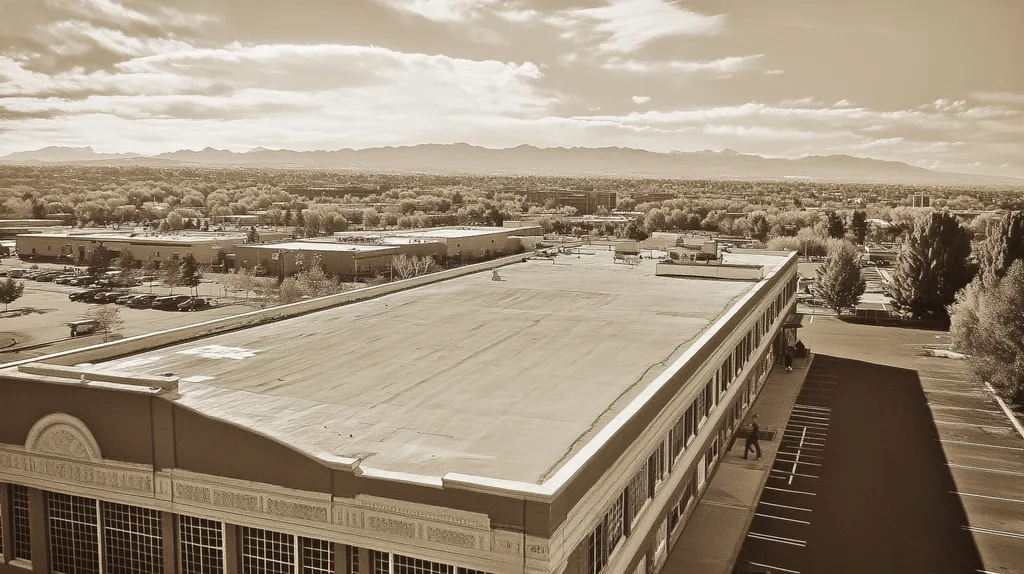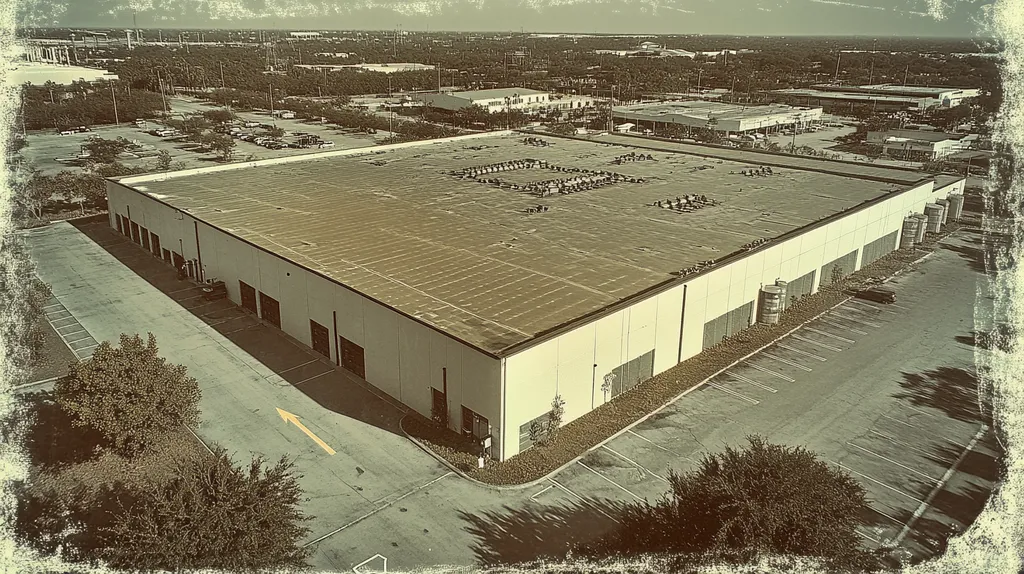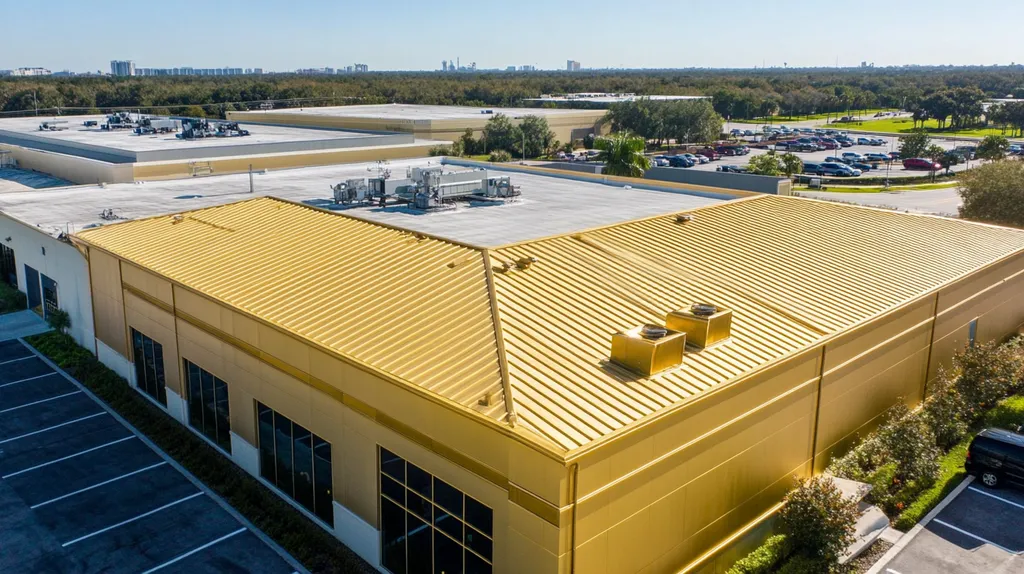Commercial roofs face unprecedented challenges, with industry data showing that 90% sustain damage during severe weather events, yet most property managers remain unprepared for emergencies.
From misunderstandings about warranty coverage to neglecting critical maintenance, these oversights cost businesses millions annually in preventable repairs.
This comprehensive guide examines common misconceptions about commercial roofing, explores their practical implications, and provides evidence-based solutions for protecting these vital assets during emergencies.
SECTION 1: COMMON MISCONCEPTIONS
Misunderstandings surrounding commercial roofs can lead to significant financial losses, especially during emergencies. Property managers frequently assume that warranties provide comprehensive coverage, believe that maintenance is unnecessary, and underestimate the risks associated with snow and ice. These misconceptions can jeopardize roof integrity and result in costly repairs when they are least expected.
Warranty Covers All Roof Issues
A widespread belief among property managers is that a warranty on a commercial roof guarantees protection against all potential issues. However, most warranties come with specific exclusions and limitations that can leave property owners at risk. For instance, damages resulting from improper maintenance or neglect are typically not covered.
This means that when a roof suffers damage from severe weather or other emergencies, the financial burden may fall on the property owner. It is crucial to grasp the details of any warranty to ensure sufficient coverage during challenging times.
Property managers should meticulously review warranty documents and seek clarification from manufacturers or contractors to understand what is included or excluded. This proactive strategy can uncover gaps in coverage that might lead to unexpected expenses.
Failure to comprehend the limitations of a warranty can result in significant costs at critical moments, thereby undermining budgeting efforts and emergency preparedness.
No Maintenance Needed with Warranty
Many property managers mistakenly believe that having a warranty exempts them from performing regular roof maintenance. This dangerous assumption can create severe repercussions, as neglecting routine inspections and upkeep can void warranties.
For instance, if a roof leaks due to a lack of maintenance—such as accumulated debris or ignoring minor repairs—the warranty likely won’t cover the damage. Regular maintenance enables property managers to address potential problems before they worsen, thereby prolonging roof life and performance.
Furthermore, documented maintenance is often a prerequisite for warranty validity, emphasizing the need for an organized maintenance schedule. Establishing a routine inspection regimen can prevent emergencies and lower long-term expenses.
Neglecting maintenance may lead to failures during critical times. Thus, it is imperative for property managers to prioritize regular evaluations of their roofs.
Snow and Ice Don’t Cause Leaks
Many property managers overlook the risks associated with snow and ice accumulation on commercial roofs. The belief that these weather elements do not contribute to leaks can be misleading, particularly in regions with harsh winter conditions. Accumulated snow and ice introduce significant weight and pressure that can compromise roof structures.
If left unaddressed, this added stress may result in leaks or even structural failures during winter storms. For example, melting snow can freeze again at the roof’s edges, forming ice dams that trap water and lead to leaks inside the building.
Understanding the potential impact of snow and ice is essential. Implementing snow removal strategies and monitoring roof conditions during winter months can help mitigate risks associated with these weather challenges.
Ignoring snow and ice buildup can lead to severe damages and high repair costs. Property managers must recognize that proactive measures are vital for maintaining roof integrity during winter emergencies.
SECTION 2: PRACTICAL IMPLICATIONS
Neglecting the maintenance and inspection of commercial roofs can lead to severe consequences for property owners. A recent study indicates that 56% of commercial building owners reported costly water damage due to unaddressed roofing issues. This section explores the impacts of neglect, the dangers of delayed inspections, and how these factors can influence a building’s temperature and energy efficiency. Understanding these practical implications is crucial for effective property management.
Impact of Neglect on Roof Integrity
The implications of neglecting roof maintenance can be profound. Over time, exposure to the elements and debris build-up can irreparably damage roofing materials, leading to leaks and structural weaknesses. For example, a roof that is not regularly cleared of debris can trap moisture, ultimately fostering mold growth and further degrading the roofing system.
Additionally, unmaintained roofs are prone to premature failures, which can escalate costs significantly. Property managers may find that much of their roofing budget is consumed by emergency repairs rather than routine maintenance, leading to inflated expenses. Furthermore, compromised roof integrity presents safety hazards for occupants, which can have severe repercussions.
Statistics indicate that neglected roofs can diminish a building’s overall lifespan by up to 30%. This alarming figure should serve as a wake-up call for property managers to prioritize regular inspections and maintenance, safeguarding both structural integrity and financial investments.
In summary, a commercial roof’s integrity is not solely about protecting against water ingress; it highlights the property manager’s commitment to safety and longevity in the face of economic realities.
Consequences of Delayed Inspections
Putting off roof inspections can lead to disastrous outcomes for commercial properties. When inspections are delayed, issues such as cracks, blisters, or standing water can worsen unnoticed. For instance, a small leak that remains undiscovered for months can escalate into significant water damage and mold growth, resulting in a much heftier financial burden.
Property owners may find themselves needing to address issues during peak seasonal demands, when contractors are least available. This scenario not only drives up repair costs but can also disrupt building operations, potentially displacing tenants during urgent repairs.
Additionally, failure to conduct timely inspections can jeopardize regulatory compliance, increasing liability risks. Such neglect can lead to higher insurance premiums and the possibility of fines or sanctions from local regulations, highlighting the urgency of maintaining a regular inspection schedule.
Therefore, conducting timely inspections is vital for upholding a proactive roofing strategy. The potential repercussions of letting inspections slide far outweigh the perceived inconvenience of scheduling regular evaluations.
Effects on Building Temperature and Energy
The condition of a commercial roof significantly influences a building’s temperature regulation and energy costs. A roof in poor condition can considerably impair insulation, leading to inefficient heating and cooling. Research shows that buildings with unmaintained roofs could see energy costs rise by up to 30% annually.
As roofing materials deteriorate, heat can escape and unwanted air can infiltrate, reducing the efficiency of HVAC systems. Property managers may observe a marked increase in energy consumption, adversely affecting financial performance. Retrofitting an underperforming roof can yield immediate cost savings through lower energy bills, making a strong case for investment in preventative maintenance.
A well-maintained roof not only acts as an insulation barrier but also mitigates extreme temperature fluctuations, ensuring a comfortable environment for occupants. This comfort can enhance tenant satisfaction and productivity, making maintenance a priority for property managers.
Recognizing the relationship between roof condition and energy efficiency is essential. Taking preventative measures ensures ongoing fiscal responsibility and operational efficiency, underscoring the critical role of roof maintenance in effective property management.
SECTION 3: COST OF MISINFORMATION
The reality is that commercial property managers face significant financial risks if they mismanage their roof systems. Research shows that unaddressed leaks can increase repair costs by as much as 30% over time. This can lead not only to expensive roof replacements but also to damaging effects on the building’s interior and vital equipment. Recognizing the financial consequences of misinformation is essential for effective roofing management.
Financial Burden of Unaddressed Leaks
Ignoring leaks can create a heavy financial burden for businesses. A small leak may seem manageable at first, but if left unaddressed, it can quickly develop into a costly issue. Water intrusion can damage insulation, electrical systems, and even vital structural components, necessitating comprehensive and expensive repairs.
Additionally, the consequences of water damage can propagate further. Mold growth and deteriorating indoor air quality might require extensive remediation efforts, adding to overall expenses. These issues can disrupt business operations, resulting in lost revenue.
For property managers, it is vital to regularly assess the condition of their roofs. Proactive inspections can identify potential leaks before they escalate, saving substantial funds in the long term. Investing in routine maintenance proves to be much more cost-effective than managing the fallout from negligence.
In emergency scenarios, being proactive is crucial. Prompt attention to roofing issues not only safeguards the building but also contributes to long-term viability.
Increased Energy Costs Due to Poor Maintenance
A well-maintained roof is critical for energy efficiency, and neglecting it can result in increased energy consumption and related costs. Poor roofing conditions can create air leaks, causing HVAC systems to work harder to maintain comfortable indoor temperatures.
For example, a compromised roof can lead to considerable heat loss during winter, which in turn raises heating costs. Similarly, summer energy expenses can surge if the roof fails to adequately reflect sunlight.
Many property managers overlook how roofing conditions directly influence energy efficiency. Regular inspections and maintenance can optimize the performance of a roof. Addressing even a small roofing issue can yield immediate savings on energy bills, demonstrating the financial sense of an overarching maintenance strategy.
In a competitive market, it’s vital to minimize operating costs while maximizing energy efficiency. By prioritizing roof maintenance, property managers can achieve both sustainability and cost-effectiveness.
Emergency Repair Costs vs. Preventative Maintenance
The financial differences between emergency repairs and preventative maintenance can be substantial. Emergency repair situations often lead to higher costs due to their urgent nature. Immediate responses require expedited services that frequently result in inflated labor rates and material prices.
For instance, a routine maintenance visit might cost only a few hundred dollars, while an emergency situation could demand thousands due to the urgent need for resources. This stark financial contrast emphasizes the necessity of having a strategic maintenance plan in place.
Furthermore, preventative maintenance facilitates better financial planning. By forecasting potential roofing issues, property managers can allocate budgets appropriately and avoid unexpected overruns. Integrating routine maintenance into building management strategies is an astute investment.
Ultimately, misinformation about roofing care can have cascading costs. By adopting a proactive approach, property managers can protect their assets and their financial health, steering clear of the pitfalls associated with reactive management.
SECTION 4: REALITY CHECK
Emergency preparedness for commercial roofs is not merely optional; it is a crucial practice that can save property owners significant costs and avoid disruption. Studies reveal that almost 90% of commercial roofs sustain damage during severe weather events. Neglecting regular maintenance and timely inspections can lead to unexpected emergencies from deterioration that could have been easily prevented. This section emphasizes the critical role of consistent roof inspections, the necessity of seasonal maintenance, and the advantages of having 24/7 emergency response teams ready to act when needed.
Importance of Regular Roof Inspections
Regular roof inspections play a vital role in preventing serious damage during emergencies. Many property owners fail to recognize the risks posed by seemingly minor issues like cracks or leaks. Ignoring these small problems can lead to catastrophic failures and costly repairs, particularly during severe weather conditions.
Routine inspections empower property managers to identify vulnerabilities before they escalate into major problems. For example, a minor leak, if left untreated, can result in water damage, mold growth, and even structural concerns. Investing in regular inspections can yield substantial long-term returns in terms of property durability.
Best practices recommend conducting inspections at least twice yearly, ideally in the spring and fall. This schedule allows property managers to promptly address maintenance needs and reduces risks associated with unpredictable weather patterns.
In essence, emphasizing regular inspections not only protects the roof but also safeguards the building’s occupants and overall operations. A proactive approach enhances emergency preparedness, ultimately leading to better outcomes during challenging situations.
Seasonal Maintenance Needs for Commercial Roofs
Seasonal maintenance is essential for ensuring that commercial roofs endure the unique challenges each season presents. For example, winter can bring heavy snowfall and ice accumulation, which may lead to structural damage and leaks if not properly managed. Conversely, summer heat can trigger thermal expansion that can affect roofing materials’ integrity.
During spring, clearing accumulated debris from winter is vital. This entails not just removing branches and leaves but also ensuring gutters and drains are clean and functioning. Blocked drainage systems can lead to water pooling, increasing the risk of leaks.
In fall, property managers should examine the roof for worn areas or damage developed over summer. Promptly identifying issues like cracked flashing or deteriorated seals can prevent major complications during the winter season.
Creating a seasonal maintenance checklist can simplify this process. By proactively addressing seasonal requirements, property managers can significantly bolster the resilience of their roofs.
Role of 24/7 Emergency Response Teams
The importance of having 24/7 emergency response teams for commercial roofs is paramount. In cases of sudden crises—such as storms, fires, or unforeseen leaks—immediate assistance is essential. Quick response times can distinguish between a minor issue and a catastrophic failure.
A dedicated emergency response team ensures that roofing issues are promptly addressed. For instance, a team trained to handle a roof leak can implement temporary solutions like tarps or sealants to prevent further water damage while a permanent repair strategy is devised.
Additionally, these teams possess the expertise necessary to quickly assess damage and identify risks that may not be visible initially. Their experience is critical, especially under pressure, facilitating informed decisions that can reduce long-term impacts on the property.
Investing in a reliable emergency response team is a strategic choice. It enhances overall emergency preparedness and minimizes business disruptions, making it essential for protecting both the property and the bottom line.
SECTION 5: EVIDENCE-BASED ALTERNATIVES
In the face of urgent challenges, proactive measures for maintaining commercial roofs become essential, especially in emergencies. According to the National Roofing Contractors Association, approximately 70% of commercial roofs fail prematurely or turn into costly liabilities. It is vital for property managers to implement evidence-based alternatives to protect their roofs effectively. This section will discuss the importance of preventative maintenance schedules, advanced inspection techniques, and energy-efficient roofing materials as critical strategies for enhancing roof durability.
Preventative Maintenance Schedules
Creating a preventative maintenance schedule is essential for extending the lifespan of commercial roofs. Regular upkeep identifies minor issues before they develop into major problems while also ensuring compliance with warranty requirements. Routine checks help property managers confirm that gutters are clear and seams are intact.
For instance, implementing biannual inspections can reveal vegetation growth or debris that traps water. This proactive measure significantly reduces the chances of leaks during heavy rainfall, which could disrupt daily operations. Utilizing a detailed checklist during inspections enhances consistency and thoroughness.
Additionally, maintaining clear documentation of maintenance history aids in budgeting and future planning. A solid maintenance plan can reduce long-term costs by as much as 50%. These records are beneficial for demonstrating due diligence during insurance claims.
Ultimately, a well-structured preventative maintenance schedule minimizes emergency calls and provides a safer environment for all building occupants. Investing in these practices is not just advisable but essential.
Advanced Inspection Techniques and Tools
Advanced inspection techniques are transforming roof evaluations. Complementing traditional visual inspections with modern tools such as infrared thermography and drone technology allows for deeper insights into hidden vulnerabilities. This combination enhances the effectiveness of roof assessments.
For example, infrared cameras can detect temperature differences, indicating trapped moisture beneath roofing materials. This enables property managers to identify current leaks and plan preventive measures. Meanwhile, drones can survey large or hard-to-reach roofs, mitigating risks associated with ladders and scaffolding.
Incorporating these technologies facilitates more frequent and thorough inspections. Regular use of drones and infrared thermography can uncover issues before they escalate into costly damages, providing crucial monitoring during severe weather.
Ultimately, these advanced inspection tools play a vital role in risk reduction. Their capacity to identify problems early leads to timely repairs and cost savings.
Energy-Efficient Roofing Materials and Practices
Switching to energy-efficient roofing materials is becoming essential for modern property management. These materials offer superior insulation and positively impact the environment. Reflective roofing surfaces significantly lower heating costs while enhancing the longevity of roofs.
For instance, while conventional roofs may absorb heat and increase cooling expenses, cool roofs reflect sunlight, keeping interiors cooler. This shift can reduce energy bills by 20-30%. The use of sustainable materials, including recycled elements, can also earn credits for green building certifications, making properties more appealing to potential tenants.
Moreover, energy-efficient practices extend beyond mere materials. Incorporating a green roofing system can provide additional insulation, a waterproof layer, and support vegetation that absorbs rainwater, which decreases runoff. These added components enhance both environmental sustainability and building efficiency.
Ultimately, investing in energy-efficient materials is more than compliance with regulations; it’s about future-proofing properties. By adopting these practices, property managers can lead the way in sustainability while also achieving cost efficiency.
SECTION 6: TEST AND VERIFY
To effectively protect commercial roofs during emergencies, regular and thorough inspections are essential. Neglecting this crucial step can result in hidden damage that may lead to costly repairs and even catastrophic failures. Studies show that proactive maintenance can extend a roof’s lifespan by as much as 50%. This section highlights the significance of conducting comprehensive roof inspections, leveraging specialized technology for effective monitoring, and instituting rigorous health and safety plans during repairs.
Conducting Thorough Roof Inspections
Regular roof inspections are imperative for maintaining a commercial roof’s integrity. It is advisable to schedule inspections at least biannually and after severe weather events. A detailed examination can reveal problems such as leaks, structural weaknesses, or deterioration of roofing materials.
During inspections, property managers should be vigilant for signs of distress, including cracked flashing or standing water. Identifying these issues early allows for timely repairs, preventing them from developing into larger, more expensive problems.
Documenting inspection results is also crucial. This record not only helps track the roof’s condition over time but is invaluable for insurance claims should damage occur. The more detailed the information available, the better positioned property managers are to make informed decisions regarding repairs.
A thorough inspection process safeguards both the investment in the roof and the safety of building occupants. Maintaining thorough documentation demonstrates a commitment to roof health and efficient building management.
Using Specialized Cameras and Drones for Monitoring
Advancements in technology have revolutionized the efficiency and efficacy of roof monitoring. Drones equipped with high-resolution cameras can quickly survey extensive roof areas without the need for ladders or scaffolding, significantly reducing risk while enhancing insight into the roof’s condition.
Semi-automated inspections using drones can pinpoint structural issues, damage, or regions in need of attention. Thermal imaging cameras are likewise useful, revealing temperature differences that indicate moisture ingress or leaks hidden from sight.
Embracing these advanced technologies enables a thorough assessment of the roof’s health, streamlining decision-making processes. Real-time data capture by drones and thermal cameras helps prioritize maintenance tasks and budget effectively.
This strategic approach not only enhances safety during inspections but also saves time and resources. By utilizing these contemporary monitoring tools, property managers can proactively address potential issues before they escalate.
Implementing Health and Safety Plans During Repairs
Prioritizing safety is critical during any roof repair project. Establishing a comprehensive health and safety plan is essential to protecting workers and mitigating risks. Prior training and appropriate equipment must be ensured before any repairs begin.
A strong health and safety plan includes identifying potential fall hazards, mandating the use of personal protective equipment, and utilizing safety harnesses or guardrails where necessary. Regular safety meetings can reinforce these precautions among repair personnel.
Additionally, emergency response procedures must be clearly outlined in the health and safety plan. This should include rescue protocols in case of an accident. Ensuring that all workers are familiar with these emergency procedures fosters a culture of safety on the job site.
By emphasizing health and safety during repairs, property managers not only comply with regulatory requirements but also protect their workforce. These measures contribute to a more effective repair process and enhance the longevity of the roof.
The Bottom Line
With 90% of commercial roofs sustaining damage during severe weather events, the stakes for proper emergency preparedness have never been higher.
The evidence clearly demonstrates that relying on warranties alone or neglecting regular maintenance leads to catastrophic failures, costing businesses millions in preventable repairs annually.
Property managers must embrace a three-pronged approach: implementing rigorous preventative maintenance schedules, utilizing advanced inspection technologies, and maintaining 24/7 emergency response capabilities.
Studies show that proactive roof management can reduce repair costs by up to 50% while extending roof lifespan by decades.
The choice is clear: invest in comprehensive roof protection now or face exponentially higher costs and risks during emergencies later.
FREQUENTLY ASKED QUESTIONS
Q. Does a warranty on a commercial roof cover all issues?
A. No, most warranties have exclusions that property managers must review carefully. Warranty coverage often does not include damages resulting from poor maintenance or neglect, which can lead to unexpected costs during emergencies. Ensure that you fully understand what is covered and excluded in your warranty to avoid potential financial burdens.
Q. What are the consequences of neglecting maintenance on a commercial roof?
A. Neglecting maintenance can lead to severe damage and costly repairs. Problems like leaks can escalate, resulting in extensive water damage and potential mold issues. Furthermore, neglected roofs may fail prematurely, significantly reducing the building’s lifespan and inflating repair costs over time.
Q. How do unaddressed leaks affect the costs of maintaining a commercial roof?
A. Unaddressed leaks can increase maintenance costs by escalating minor problems into major repairs. Water intrusion can damage insulation and electrical systems, leading to comprehensive remediation efforts. Regular assessments can help identify leaks early, saving substantial money in the long run compared to managing extensive water damage.
Q. Why is emergency preparedness important for commercial roofs?
A. Emergency preparedness is crucial to minimize damage during severe weather events. Well-maintained roofs are less likely to sustain damage, ultimately saving property managers from costly repairs. Regular inspections and having a response plan can protect structural integrity and ensure prompt action during emergencies, reducing potential disruptions.
Q. How does seasonal maintenance benefit commercial roofs?
A. Seasonal maintenance is vital for addressing unique weather challenges each season presents. Regularly maintaining roofs before harsh weather conditions can prevent structural damage and leaks. By creating a maintenance checklist tailored to specific seasons, property managers can enhance roof durability and effectively mitigate risks associated with environmental stressors.
Q. What role do advanced inspection techniques play in roof maintenance?
A. Advanced inspection techniques, like drones and thermal imaging, enhance roof evaluations. They provide insights into hidden vulnerabilities, allowing for timely intervention before issues escalate. Utilizing these technologies ensures thorough assessments of roof health, streamlining maintenance and improving overall efficiency in managing roofing systems.
Q. How can energy-efficient roofing materials impact commercial properties?
A. Energy-efficient roofing materials enhance insulation and lower energy costs. These materials can reflect heat, reducing cooling expenses significantly. Additionally, using sustainable options can improve green certifications, making properties more appealing to tenants and contributing positively to long-term operational costs and environmental responsibilities.

